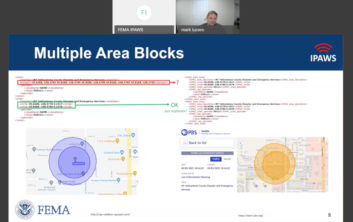 There’s a list of “the good, the bad and the ugly” when the Federal Emergency Management Agency migrated the nation’s IPAWS system to the cloud this past April.
There’s a list of “the good, the bad and the ugly” when the Federal Emergency Management Agency migrated the nation’s IPAWS system to the cloud this past April.
According to IPAWS Engineering Chief Mark Lucero during a webinar on the transition, there were many reasons to move the IPAWS system from the legacy, on-premises data center into the Amazon Web Service (AWS) cloud environment. The cloud offers new levels of redundancy and native tools that will help IPAWS function faster, better, stronger and cheaper, he said.
But like any migration from a standalone on-premises system to the cloud, there were bumps along the way. There were also several smart moves that FEMA and the Department of Homeland Security made. For one, Lucero said, FEMA successfully handled upfront planning, architecture design and in-depth planning with stakeholders. The cloud also gives the agency more rigorous redundancy. “We have redundancy on top of redundancy on top of redundancy,” Lucero said. “If a server goes down in flames, there are two more buildings within 100 miles that can pick up the slack and continue working as if nothing has happened.”
[Read: FEMA Dials up IPAWS Playbook]
The cloud environment also offers a faster turnaround time for adding new features and functions. “In the past it would take us several months to implement a change,” Lucero said. The cloud also offers the agency a new, centralized control system. “One of the great things that we’ve done by pushing into cloud is that we’ve centralized control,” he said. “Now we have more control over more aspects of it. There’s still a lot of oversight and security requirements that DHS puts on us; however, we have [fewer physical assets] to go to if we need to fix something.”
That’s the good. But speed bumps were in there too. Lucero said the agency struggled with deadlines, with removing bugs, with network connectivity and with coordination with broadcasters when it came to testing code. “When trying to swing over 11 systems operated by cell carriers that had their own priorities, we made a projection as to how long this would take and we were way off,” Lucero said.
He said that FEMA could also do a better job of anticipating how a delay here might affect a deadline over there. That led FEMA to reschedule its go-date a few times. “The original plan was to get this done in calendar year 2020,” he said.
Then there was the ugly, Lucero said. He said there was scant guidance from FEMA on cloud implementation when the cloud conversations first began back in 2018. Another issue: at the same time that FEMA was working on its cloud transition, it was also trying to make updates to the legacy IPAWS environment. “That was kind of tough because we had some delays … and those delays directly affected our cloud migration timeline and made things difficult,” he said.
Lucero said that paperwork requirements, approvals and security evaluations put the project somewhat behind. And the transition team struggled with retooling its testing procedures. “On the government and contractor side, we need to do a better job of defining how that process is going to take place,” he said.
Lucero was speaking as part of a cloud transition webinar set up by the IPAWS Program Management Office. Information on upcoming changes — including URL upgrades, information on when the older system will be decommissioned and what broadcasters need to know next — is contained within the nearly hour-long webinar.







